Read more about cannabinol, known as CBN, discover why this cannabinoid has earned the nickname ‘the sleep cannabinoid,’ and learn how to make CBN oil at home following a simple oil infusion process.
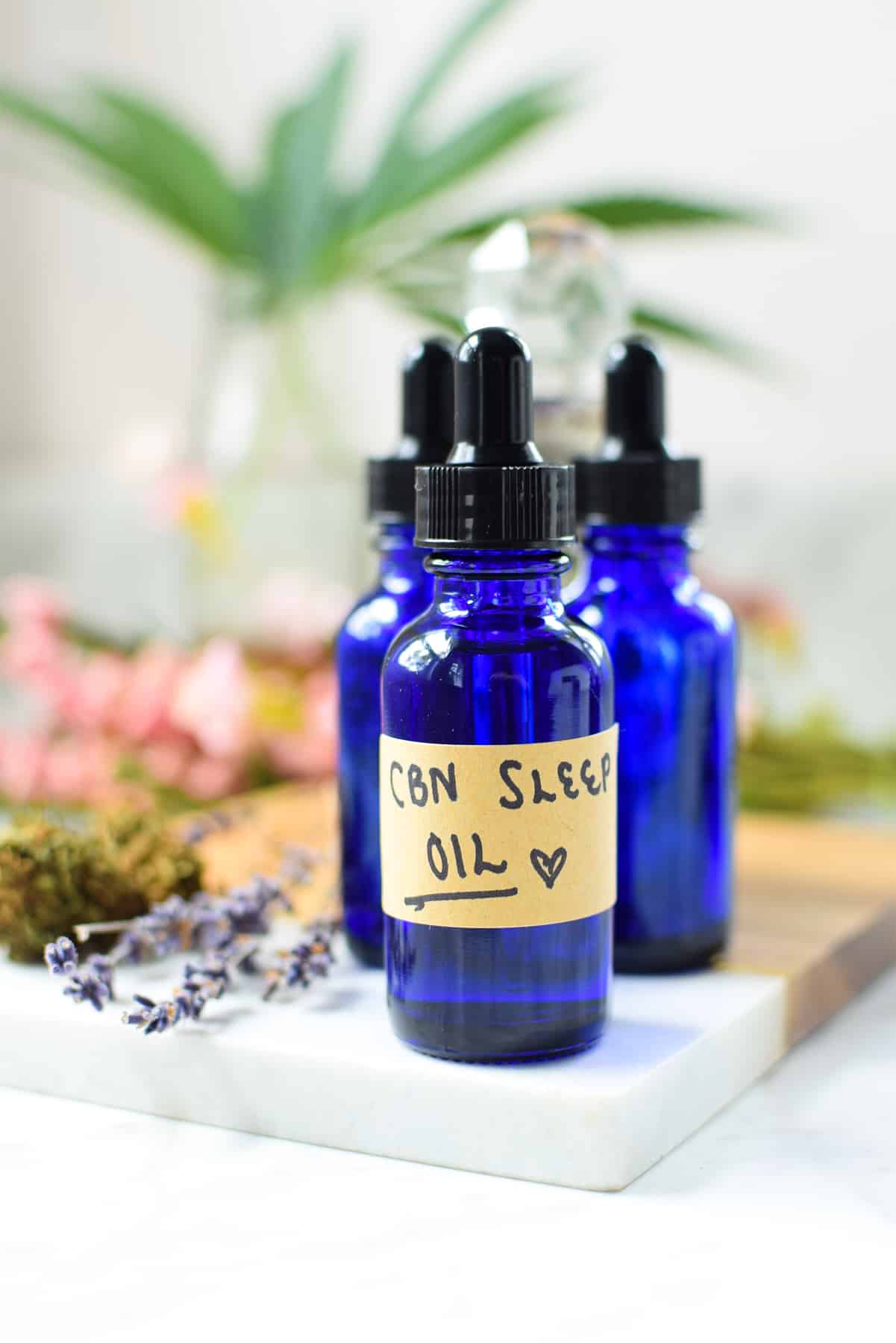
Table of Contents
- Article Features
- Why You Will Love This Recipe
- What You’ll Need
- The Step-by-Step Process
- Storage Instructions
- About CBN
- How To Decarb To Get CBN
- Why is CBN Called The ‘Sleep Cannabinoid’?
- What Are The Effects and Side Effects of CBN?
- Make or Buy CBN Oil
- Sleepy CBN Oil Recipe (Cannabinol) Recipe
- Frequently Asked Questions
- More Sleep Resources For You
Article Features
- Made with two simple ingredients: THC flower & oil
- Perfect if you want a homemade alternative to sleep medications
- Want to skip the hard work? Shop with me and have my premium CBN Sleep Oil delivered directly to your door. Now shipping across the United States!
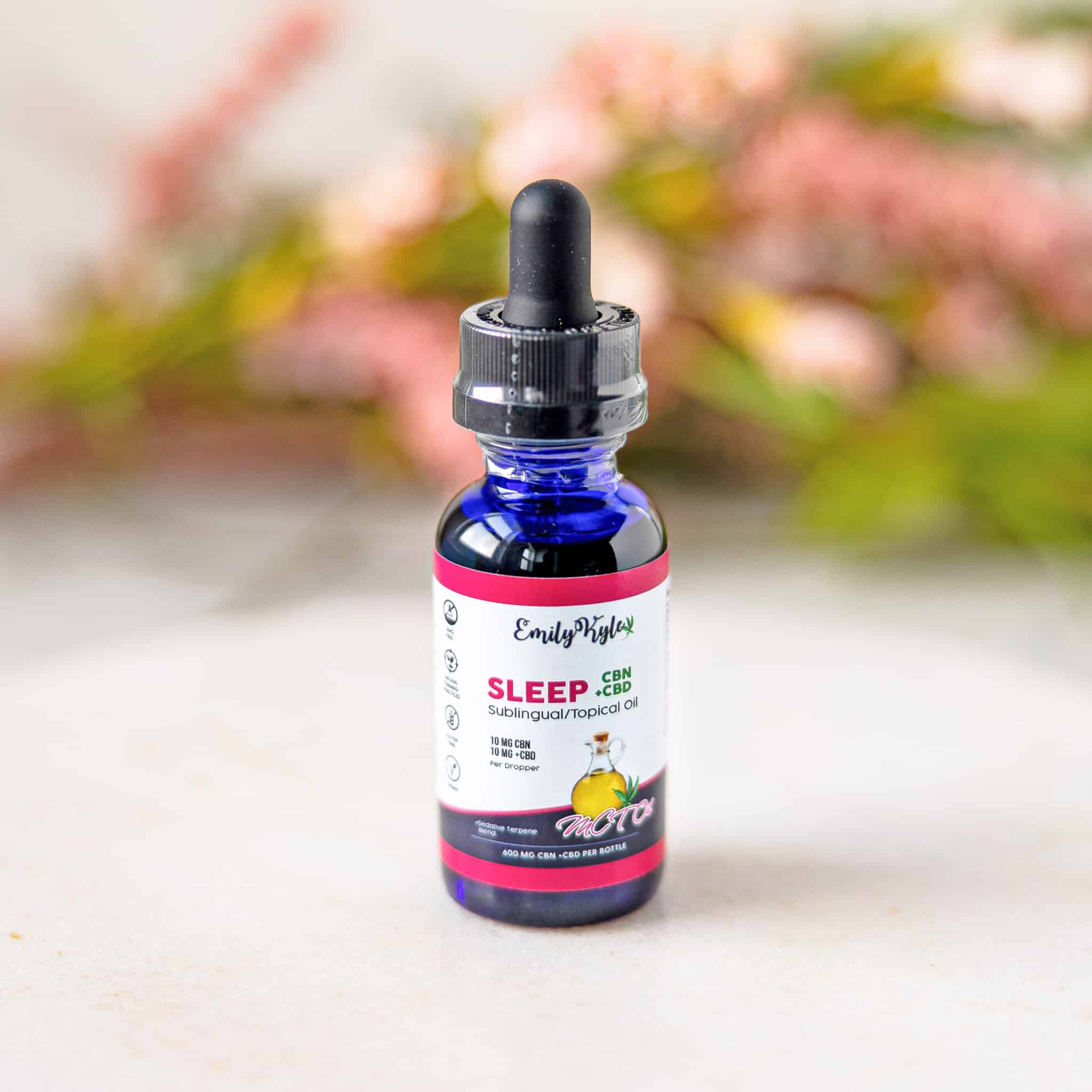
Why You Will Love This Recipe
The cannabis plant contains more than 100 cannabinoids, which give the plant its powerful properties.
While you usually hear about CBD and THC, the minor cannabinoid called cannabinol, or CBN, has been getting a lot of attention due in my Well With Cannabis Community to its unique sleep effects.
But what is CBN, why is it nicknamed the sleep cannabinoid, and is it right for you?
In this guide, we will review CBN’s potential benefits, and I will show you how to make your own CBN oil at home.
What You’ll Need

- THC Flowers – To make a CBN oil at home, you must start with a cannabis flower that has THC already present. Aged cannabis is a great option, too. You can purchase this from your local dispensary.
- Lecithin, optional: If you’re new to working with lecithin, you can learn more about adding lecithin to edibles here. If needed, you can purchase liquid lecithin or powdered lecithin. This ingredient is optional.
- Carrier Oil Of Choice– There are many oil options to choose from. Unsure what to pick? Check out my guide to understanding different types of cannabis oils here.
Note: a complete list of ingredients with amounts and printable instructions is located in the recipe card below.
The Step-by-Step Process
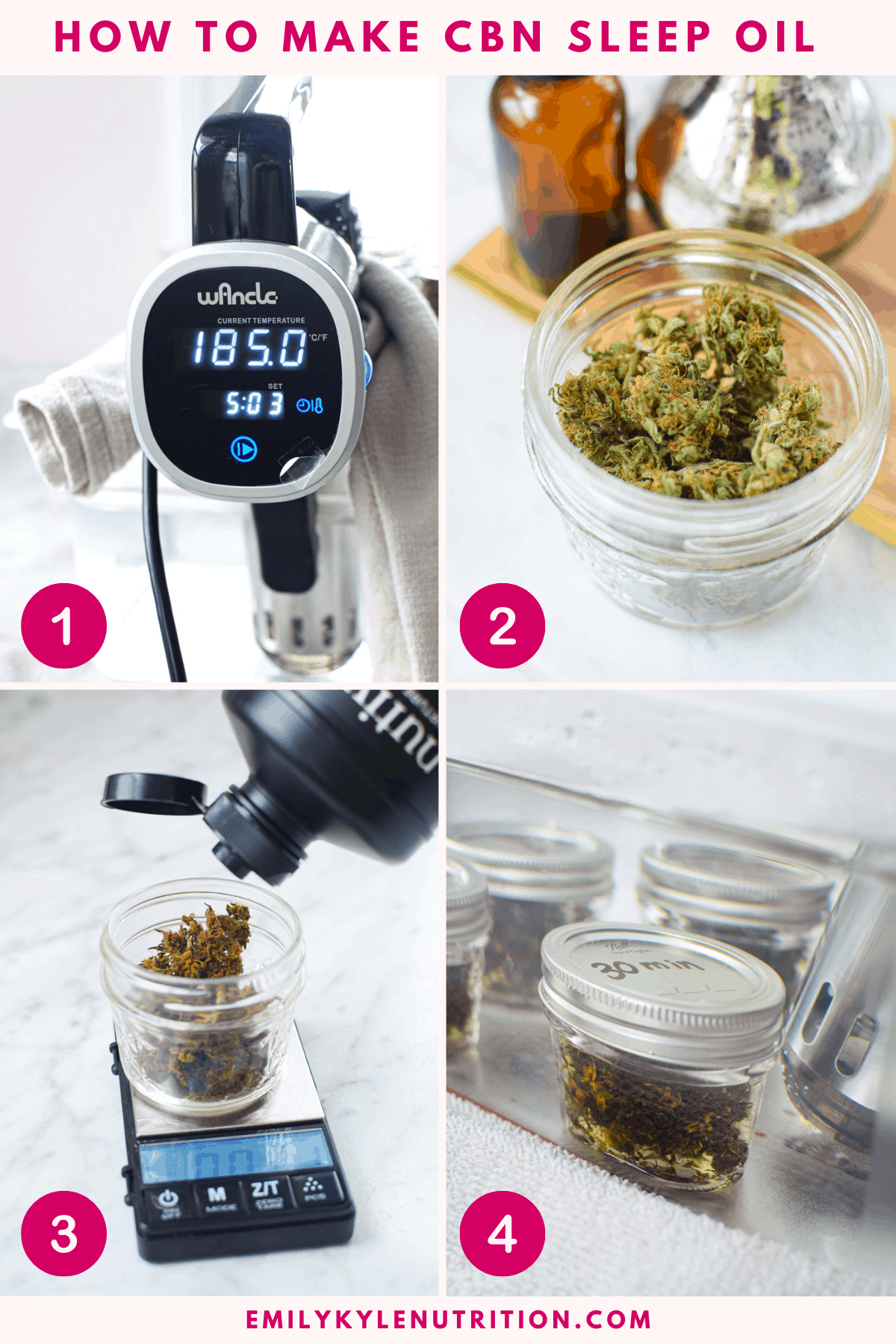
- Step 1 – The goal is to create a water bath that stays at approximately 180-190° F for the cooking process. The printable instructions in the recipe card below are for using a crockpot to create the water bath.
- Step 2 – While the water bath is heating in the crockpot, measure and decarb the THC flower in the oven at 240° F for 180 minutes. See more information on how to decarb for CBN below.
- Step 3 – Evenly divide the decarbed cannabis flower and MCT oil between the mason jars you plan on using. If you plan on using sunflower lecithin, add it to the mason jars now.
- Step 4 – Carefully place the jars into the water bath. Then, place the lid on the crockpot and leave it alone to infuse for 4 hours. After 4 hours, remove the jars from the hot water and allow them to cool.
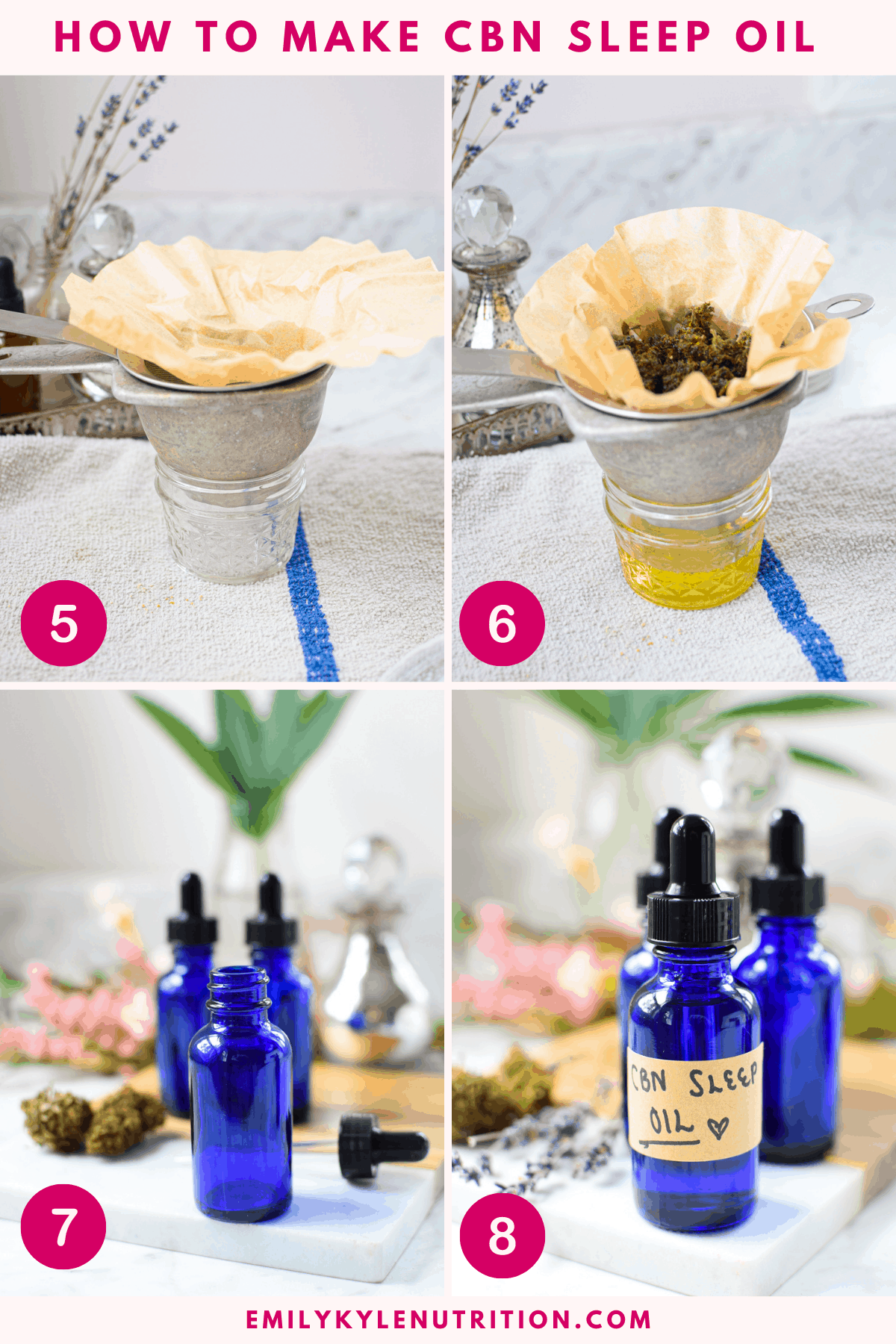
- Step 5 – Whether it be a paper filter and funnel, cheesecloth, French press, or a simple coffee filter, you will want to set up a straining station to separate the plant matter from the oil.
- Step 6 – Once cool enough to handle, strain the prepared oil with your method of choice. You can save the leftover cannabis pulp for use in future recipes.
- Step 7 – Return the prepared CBN oil to whatever jar you would like to store it in; I use a small blue tincture dropper bottle.
- Step 8 – Store the prepared CBN oil in a cool, dry place. It will last longer if stored in the refrigerator and even longer if stored in the freezer.
Note: Complete step-by-step printable instructions are located in the recipe card below.
Storage Instructions
Store your prepared CBN oil in a cool, dry place. It will last longer if stored in the refrigerator and even longer if stored in the freezer.
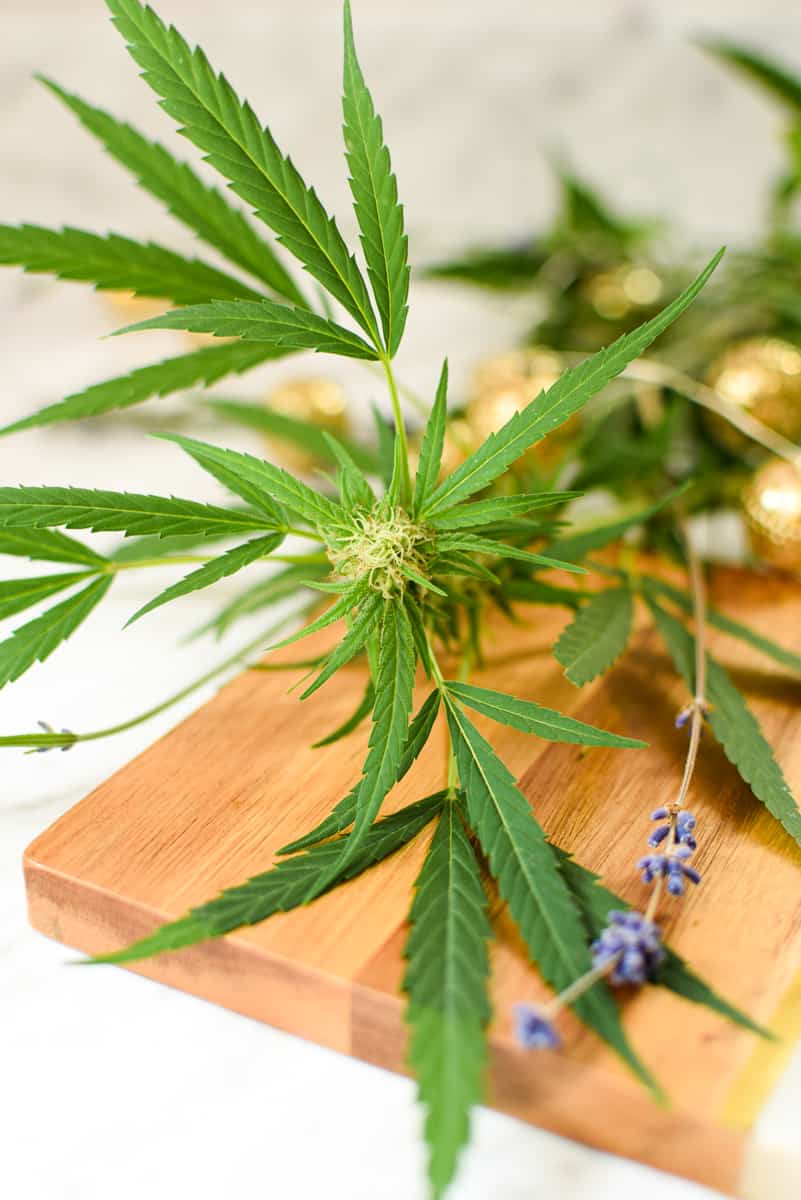
About CBN
Unlike CBD or THC, CBN is typically found in cannabis in trace quantities – also known as a minor cannabinoid.
CBN is what you might call ‘the product of patience,’ slowly developing THC transforms over time.
With a little nudge from UV light, heat, or just plain old neglect, THC starts a transformation that leads to the creation of CBN.
CBN’s claim to fame lies in its potential to produce sedative effects, offering a natural bridge to restful sleep and relaxation.
Anecdotal reports from my cannabis community attribute CBN to the power to soothe insomnia and anxiety.
How To Decarb To Get CBN
According to a decarboxylation study of acidic cannabinoids published in Cannabis and Cannabinoid Research, “Δ9-THC itself readily oxidizes to cannabinol (CBN) with oxygen and light during the decarboxylation process”.
The study goes on to note that the “formation of an oxidation product, CBN, was observed at 160°C and 180°C” (2).
For my Fahrenheit friends, that is 320°F to 356°F.
At these high temperatures, I’ve seen THC being converted into CBN in 90 minutes.
Of course, many people prefer to decarboxylate at lower temperatures in order to preserve the valuable terpenes present in the plant.
Because decarboxylation operates on a time-to-temperature scale, we can decarb for CBN at a lower temperature for a longer period of time to achieve CBN formation.
If you want to stick with the traditional 240°F used for decarboxylation, it is recommended to decarb for 180 minutes (as opposed to 40 minutes for THCA to THC conversion or 90 minutes for CBDA to CBD conversion).
You can also try to decarboxylate for CBN using the Instant Pot.
*Please note: I do not yet have lab tests to confirm these times and temperatures for CBN formation.
These recommendations are based on anecdotal reports of what is currently working for consumers inside my Well With Cannabis Community.
Follow this process at your own discretion, and consider starting with a small batch according to the chart shared below.
Why is CBN Called The ‘Sleep Cannabinoid’?
CBN is commonly referred to as ‘the sleep cannabinoid’ or ‘the sleepy cannabinoid’.
Consumers who have aged cannabis that has been sitting around for a while (years) report that they find that it produces more sedative effects than fresh cannabis.
As THC further breaks down into CBN, this effect becomes even more pronounced.
Through Dr. Russo’s research, it has been found that “CBN can be sedative, anticonvulsant in animal and human studies, and has demonstrated significant properties related to anti-inflammatory, antibiotic, and anti-MRSA activity” (3).
With millions of Americans dealing with mild to severe insomnia, CBN has been getting a lot of attention from health practitioners and consumers alike.
While more research is needed before anyone can make definite claims, many consumers hope that CBN may one day replace addictive and potentially dangerous prescription sleep medications.
What Are The Effects and Side Effects of CBN?
Before you start making or using CBN, it’s important to understand both the positive effects and the potential negative side effects.
First, it’s important to note that pure, isolated, CBN won’t make you sleepy.
Like most cannabinoids, it works best when combined with other cannabinoids and terpenes, as a part of ‘The Entourage Effect‘ theory proposed in the British Journal of Pharmacology (4).
This theory believes that a full spectrum of cannabinoids produces a more powerful effect than isolated cannabinoids on their own.
CBN is often combined with a complementary cannabinoid, like CBD, to produce ideal effects.
CBD and CBN can work synergistically to relax and produce calming feelings.
On the other hand, some users report that they experience grogginess and dry mouth as a result of consuming CBN.
It’s also not uncommon for your body to get used to CBN, which can only be avoided by giving your body tolerance breaks, switching products, or increasing your dosage.
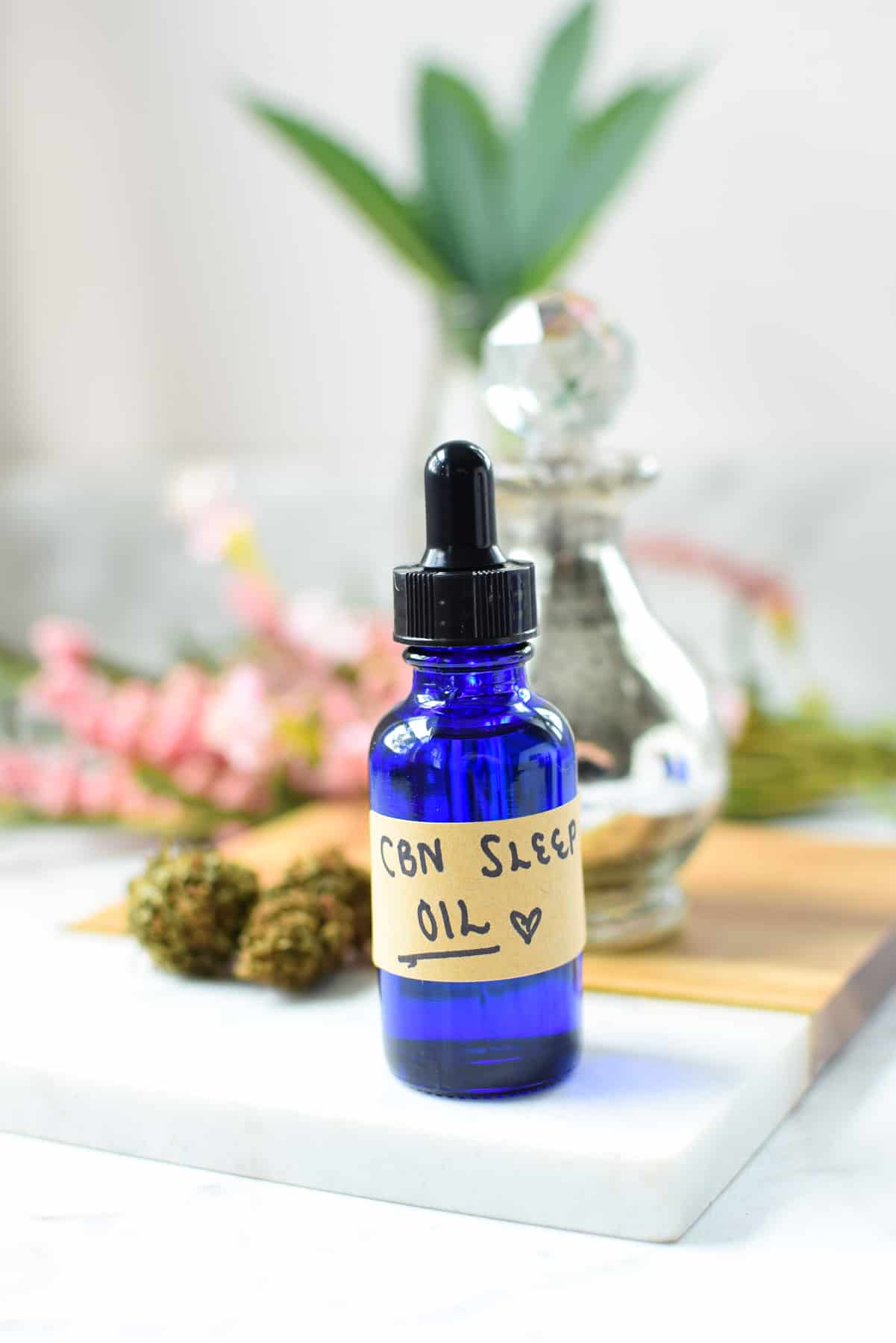
Make or Buy CBN Oil
The best part is that CBN, unlike some other cannabis products, is not directly considered a controlled substance.
This means more and more CBN products are appearing on the market, like sublingual tinctures, capsules, or even tea bags.
However, many CBN products may fall into a legal gray area depending on where you live, so it’s important to be careful and check your local regulations.
While you can purchase CBN products from my shop, you can also make your own CBN oil at home from cannabis flower by breaking down the THC into CBN.
Aging the cannabis with exposure to air will produce more oxidation, and the more oxidation there is, the more of the THC will degrade in CBN.
Unfortunately, most people don’t have aged cannabis available or the patience to wait.
The next best option to get the desired results is to take your THC-dominant cannabis flower and expose it to heat for a long period of time through the decarboxylation process.
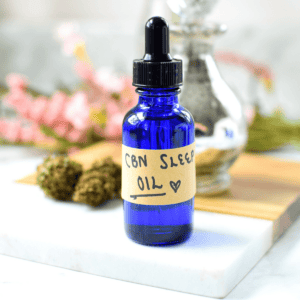
Sleepy CBN Oil Recipe (Cannabinol)
Ingredients
- 2 ounces MCT oil
- 3.5 grams THC cannabis flower
- 1/4 teaspoon liquid sunflower lecithin optional
Instructions
- Lay a clean tea towel down on the bottom of the crockpot. This will create a buffer between yourmason jars and the crockpot, potentially preventing any jar moving or cracking during cooking.
- Fill your crockpot with enough warm to hot water to cover the top of the mason jars you plan on using by an inch to create a water bath.
- Place the digital thermometer into the water. Start the crockpot heat on high. When a temperature of 185° F is reached, turn the crockpot to low.
- While the water bath is heating in the crockpot, measure and decarb the cannabis flower in the oven at 240° F for 180 minutes. Click here for a full cannabis decarboxylation tutorial, if needed.
- Evenly divide the MCT oil between the mason jars you plan on using. You can either use pint-sized or half-pint-sized jars, it’s you’re preference, just be sure they fit in your crockpot. No matter the size, be sure to leave a 1/2 inch headspace from the top.
- If you plan on using sunflower lecithin, add it to the mason jars now.
- Evenly divide the decarbed flower between the MCT oil-filled jars. Stir well. Wipe the rim of the jars with a clean paper towel and place the lid on. Tighten the metal ring to finger-tip tightness, it does not have to be tightened all the way. Do not tighten too tightly.
- Once the water bath reaches a temperature of 185° F, carefully place the jars into the water bath.
- Place the lid on the crockpot and leave it alone to infuse for 4 hours.
- After 4 hours, carefully remove the lid, followed by the jars from the hot water. Set them aside to cool.
- Once cool enough to handle, you will want to strain the MCT oil through a paper filter and funnel, cheesecloth, or French press to separate the plant matter from the oil.
- Save the leftover cannabis pulp for use in future recipes. Then return the prepared cannabis oil to whatever jar you would like to store it in. We use a small amber tincture jar.
- Store the prepared CBN oil in a cool, dry place. It will last longer if stored in the refrigerator and even longer if stored in the freezer.
Notes
- Temperature Control: The water bath does not need to stat perfectly at 185° F the entire time. Any temperature between 170°-190°F is OK.
- Safety First: I recommend you sanitize your jars by keeping them submerged in the 185° F crockpot for 10 at least minutes. This step is not necessary, but good practice for safety and hygiene.
- Floating Jars: Sometimes the mason jar will float when placed in the water bath. This is no need for concern, simply put something heat and water safe over the top of the jar to weigh it down, a clean rock works well.
- Alternative Carrier Oil Options Include:
- Olive oil, Avocado oil, Hemp seed oil, Grapeseed oil, Coconut oil
Nutrition
Frequently Asked Questions
You can choose whatever carrier oil you desire to make your infused oil, it does not need to be MCT oil. You can experiment with the following cooking oils: coconut oil, olive oil, avocado oil, sunflower seed oil, grapeseed oil, canola oil, soybean oil, safflower oil
In theory, using lecithin will make valuable cannabinoids like CBD, THC, or CBN more bioavailable or ready for use by the body. You will still have a great infused CBN oil if you don’t use lecithin; this recipe is not a make-or-break ingredient. If you use lecithin, I recommend working with a liquid lecithin option rather than a powdered or granulated version, as it will mix in easier.
Store your prepared CBN oil in a cool, dry place. It will last longer if stored in the refrigerator and even longer if stored in the freezer.
More Sleep Resources For You
Articles & How-To Guides
The Ultimate Guide to CBN » For Sleep
Articles & How-To Guides
Cannabis for Sleep: Can It Help You Get Your Best Rest Ever?
Shop with Emily
Shop Now: CBN Sleep Oil
Shop with Emily

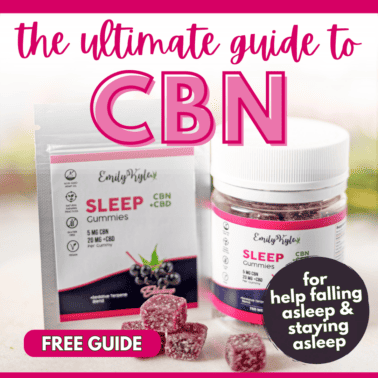
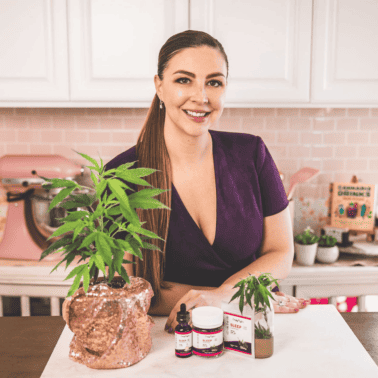
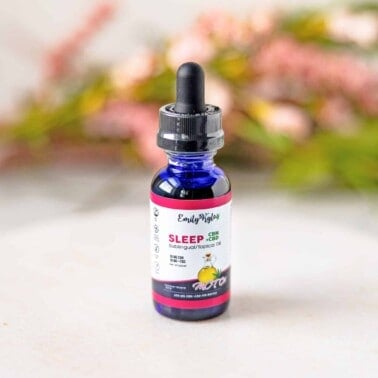










I don’t feel confident myself making it can it just be bought
Hello Kim! Yes, of course, we have this CBN sleep oil for sale in our shop, and we also have CBN sleep gummies as well, depending on your preference 🙂
Decarbing Question.
On your general recommendations to make CBN (decarbing the THC at 240 degrees for 180 min)….is this for fresh bud or already aged bud? Or does it matter? I just don’t want to over cook “old bud” or undercook fresher bud?
BTW…I love your site!!! Thank you for sharing your knowledge and information!!!
Sandy
Hi Sandy. If you’re using older bud that is dry and crisp, you should definitely monitor the decarb process so it doesn’t burn the bud. You can take it out close to the end if you see it making a turn for the worse. You will only have an issue with fresh bud if it hasn’t gone through proper drying and curing. There will be extra moisture in the bud, so at the end of the decarb cycle, your bud should be golden brown and aromatic. If it’s still green and somewhat moist, you’ll want to leave it in a bit longer. I don’t think you’ll have to worry though when decarbing for CBN. I hope this helps!
Hello love your blog.I have a question lol. I have Vaped Cannabis it’s like a mixture INDICA,hybrid,Sativa plus I have old CBD . I didn’t finish vaping. It is now to harsh to smoke.
I want to make my own gummies since they don’t offer them in my state.
I have bought everything to make Gummies. I don’t want to get Bad munchies from CBD gummies,but they maybe impossible lol. I want them for sleeping or morning.
Also I can buy INDICA Pills at my dispensary but they r $36 for 10mg pill. Heck idk what to make if I should do.
Or just make a oil to consume sublingual?
Also I do have epilepsy if maybe there is a certain cannabis I should use? Sorry so long.
Hi Melissa. There’s so many options that it can be hard to know what to do! Many of our Well With Cannabis Community members report that using AVB (already vaped bud) provides a mild, desirable, intoxicating, and often sleepy effect. If you’re looking for a sleep product, AVB would be great to use for Emily’s CBN Oil recipe. There is a process you’ll want to do prior to infusing any oils though. You can find that here in Emily’s guide on AVB: https://emilykylenutrition.com/make-avb-edibles-with-already-vaped-bud/
Hi Emily and team. Can you make an alcohol tincture with CBN or should you only make it with oil? I would like to combine my THC alcohol tincture with a CBN tincture to make hard candy.
Hi Denise. You can use CBN just as you would THC or CBD. The only thing different would be the decarboxylation process, but everything all other steps will remain the same. I hope this helps!
I have made thc oil with mct and lethicin, if I put it back in crock pot and cook at higher temp will it turn into cbn?
Hi Julie. I’m not sure the crockpot temperature gets high enough to convert to CBN, so you can run it on high for another 4 hours. You decarbed the flower that you used in your oil, correct?